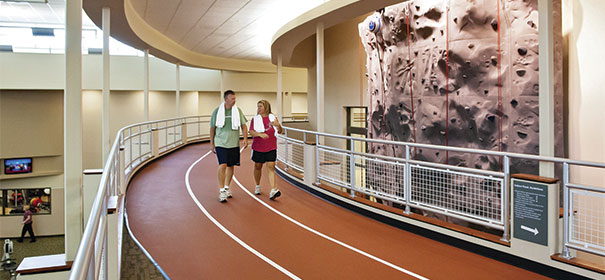 |
|
PHOTO COURTESY OF AKRON GENERAL HEALTH SYSTEM Akron General Hospital’s medical fitness center features a track that winds past a climbing wall. |
In 2013, after enduring months of rehabilitation to recover from a car accident caused by a drunk driver, Vicki Lynn Younkin, then 53, decided to get physically fit for the first time. The fitness center she chose was near her home and was familiar — it was the same place where she received her rehab care.
One of three run by Akron General Health System, the facility is called Health & Wellness Center–Green. Far from a traditional health club, the sprawling 98,000-square-foot facility brings together outpatient services, a stand-alone emergency department, radiology, sports medicine, physical therapy, orthopedics and cardiac rehab, and aqua therapy. Former rehab patients pay to become members of LifeStyles, a fitness program. Next door, a 40,000-square-foot medical office building houses Akron General physicians.
The center, built through a partnership with national developer Rendina Healthcare Real Estate, has hundreds of pieces of cardiovascular and weight-lifting equipment, an indoor lap pool and warm water pool, a gymnasium, indoor and outdoor running tracks, a youth fitness area, exercise studios and an indoor rock climbing wall.
Medical fitness dates to the 1980s. There was a burst of construction and new affiliations from the late 1990s to the economic crash of 2008, but some of it consisted of rebranding existing health clubs, not true medical fitness facilities, says Bob Boone, CEO and president of the Medical Fitness Association, Richmond, Va.
More recently, the advent of accountable care organizations and other efforts to improve population health have compelled many systems to seek solutions outside the traditional “sick care” model.
“I knew all the way back 20 years ago before we started our first center that if we in this industry didn’t pay attention to the prevention side of the health care equation, we would likely run out of money and we would likely run out of providers,” says Thomas L. Stover, M.D., president and CEO of Akron General. “It turns out we have done both.”
Surveys from the Medical Fitness Association and other sources show that the number of centers has grown from 79 in 1985 to 1,284 in 2014.
The medical fitness part of wellness centers is usually paid out-of-pocket, and a facility easily can drive $2 million to a system’s bottom line, says Doug Ribley, senior vice president of health and wellness services for Akron General.
A more compelling financial motive is that the centers are being used strategically to either protect existing or create new market share. “These centers become a community hub, with lots of different clinical services and retail-oriented wellness services,” Ribley says. “This is a branding strategy.”
Ribley and Stover have become proselytizers for the medical fitness movement. In fact, the system has turned its intellectual property into a consulting, design and operations business called Akron General Health & Wellness Innovations. It works with clients first to produce a feasibility study of market needs, competition from health clubs and other providers, geographic barriers and demographics.
“The goal is to rightsize the facility to the market,” says Matt Edwards, director of business development for the Innovations subsidiary.
Akron General also partners with real estate developers to help finance and build the projects for clients interested in that help. With access to capital scarce, it can be a particularly valuable service.
Last August, the Cleveland Clinic agreed to invest $100 million in Akron General Health System as a minority owner. The deal will allow the clinic to buy Akron General after Sept. 1. Stover says that Cleveland Clinic will enable his system to advance the mission of wellness more thoroughly and quickly.
“We believe that every health system in the country is going to have this type of facility within the next 10–15 years,” he says.


